

Future Tomb of Queen Margaret - Medieval Histories. The future Tomb of Queen Margaret has already been designed while archaeologists are currently digging where its is going to be raised Plans are now going ahead for the future reinterment of the remains of Richard III in Leicester.

At the same time (summer 2013) archaeologists are digging in the Cathedral in Roskilde in Denmark. As a World Heritage site, the Cathedral is famous for having the largest number of royal burials in the world. The dates range from Sven Estridsen (1019 – 74) – nephew of Canute the Great – to Queen Ingrid (1910 – 2000). Anastasia of Kiev. Anastasia of Kiev (c. 1023 – 1074/1096) was Queen of Hungary as the wife of King Andrew the White.
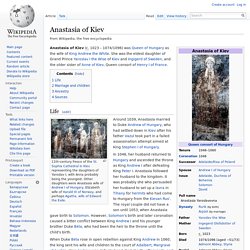
She was the eldest daughter of Grand Prince Yaroslav I the Wise of Kiev and Ingigerd of Sweden, and the older sister of Anne of Kiev, Queen consort of Henry I of France. Life[edit] Around 1039, Anastasia married to Duke Andrew of Hungary, who had settled down in Kiev after his father Vazul took part in a failed assassination attempt aimed at King Stephen I of Hungary. In 1046, her husband returned to Hungary and ascended the throne as King Andrew I after defeating King Peter I.
Anastasia followed her husband to the kingdom. Confessions of a Ci-Devant: 19th July, 1543: The Death of Mary Boleyn. We have no way of knowing how old Mary Boleyn was when she died in July 1543.
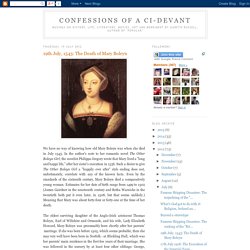
In the author's note to her romantic novel The Other Boleyn Girl, the novelist Philippa Gregory wrote that Mary lived a "long and happy life," after her sister's execution in 1536. Such a desire to give The Other Boleyn Girl a "happily ever after" style ending does not, unfortunately, correlate with any of the known facts. Anastasia of Kiev. The Trial of Queen Caroline. Today we continue our series of blogposts featuring items in our major current exhibition, Magna Carta: Law, Liberty, Legacy.
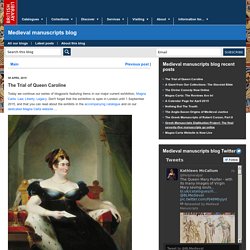
Don't forget that the exhibition is open in London until 1 September 2015, and that you can read about the exhibits in the accompanying catalogue and on our dedicated Magna Carta website ... Portrait of Caroline of Brunswick by James Lonsdale (image courtesy of City of London Corporation) On 8 April 1795, in the Chapel Royal, St James’s, George, Prince of Wales, the future King George IV (reigned 1820–30), married his cousin, the German Princess Caroline of Brunswick-Wolfenbüttel.
It was not to be a happy union. When the marriage broke down very publicly in 1820 it scandalised the nation. From the outset the marriage was never going to be a success. Queen Caroline, Britain’s Best Hope. As soon as George IV became king in 1820, Caroline immediately returned to England to claim her place as Queen of England. Katheryn of Berain, 'The Mother of Wales' (1534/5-1591) Date: 1568 Media: oil on panel Size: 97.2 x 68.6 cm Acquired: 1957; Purchase Accession Number: NMW A 19 Katheryn of Berain clutches a prayer-book and solemnly caresses the contours of a human skull.
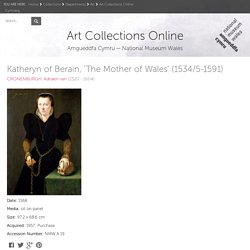
Pedigree: Catherine (of Berain) verch TUDOR. Did 16th century wealthy Welsh heiress poison three of her four husbands? ON THE surface, her story has all the elements of a lurid modern romance.
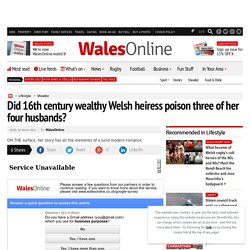
A young, beautiful gentlewoman from North Wales, connected by blood and marriage to some of Wales’ most influential families – and perhaps the Tudors – marries four times, and outlives three of her husbands. Did this wealthy heiress poison her husbands with her own hand, and kill a succession of lovers? Did she callously agree to marry her second husband on the way to the funeral of her first? Was Katheryn of Berain a 16th century villainess? Katherine (Tudor) Salisbury 1545 - 1591 Berain, Wales. Born in Berain, Wales [sibling(s) unknown] Died in Interred at Llanbydd, Wales This page has been accessed 954 times.
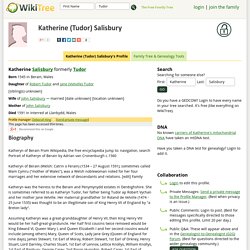
Biography. Henry Tudor’s Forgotten Bride. There have been many debates about the legitimacy of the Beauforts, and their claim to the throne.
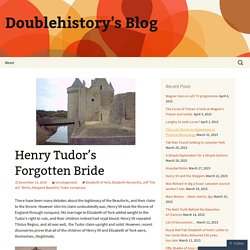
However slim his claim undoubtedly was, Henry VII took the throne of England through conquest. His marriage to Elizabeth of York added weight to the Tudor’s right to rule, and their children indeed had royal blood. Henry VII repealed Titulus Regius, and all was well, the Tudor claim upright and solid. However, recent discoveries prove that all of the children of Henry VII and Elizabeth of York were, themselves, illegitimate. Henry Tudor lived in exile with his uncle Jasper Tudor, Earl of Pembroke from 1471 to 1485. Thought to have fathered at least one illegitimate child in Brittany, Roland De Veleville, it has been long accepted that Henry Tudor was of loose morals while living in exile, taking pleasure where he found it, and moving on. When Edward IV died unexpectedly in April, 1483, things changed dramatically. Margaret Beaufort was not to be deterred. Anne Boleyn’s Letter to Stephen Gardiner. Stephen Gardiner This letter was written by Anne Boleyn on 4 April 1529 and is important because not many of Anne’s letters from the period of the divorce survive and, furthermore, it demonstrates the personal interest Anne took in the divorce proceedings.
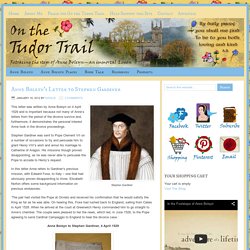
Stephen Gardiner was sent to Pope Clement VII on a number of occasions to try and persuade him to grant Henry VIII’s wish and annul his marriage to Catherine of Aragon. His missions though proved disappointing, as he was never able to persuade the Pope to accede to Henry’s request. In this letter Anne refers to Gardiner’s previous mission, with Edward Foxe, to Italy – one that had obviously proven disappointing to Anne.
Elizabeth Norton offers some background information on previous embassies: ‘The pair had visited the Pope at Orvieto and received his confirmation that he would satisfy the King as far as he was able. Anne Boleyn to Stephen Gardiner, 4 April 1529 A copy of Anne Boleyn's letter to Stephen Gardiner Master Stephen. England Under The Tudors: Mary Tudor, Queen of France (1496-1533) Ralph Cromwell, 4th Baron Cromwell (1394?-1456) RALPH CROMWELL, fourth Baron Cromwell (1394?
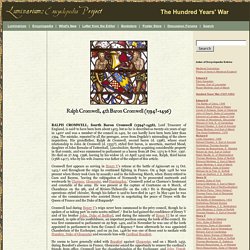
-1456), Lord Treasurer of England, is said1 to have been born about 1403, but as he is described as twenty-six years of age in 14202 and was a member of the council in 1422, he can hardly have been born later than 1394. The mistake, repeated by all the peerages, arose from Dugdale's misreading of the above inquisition. His grandfather, Ralph de Cromwell, second baron (d. 1398), whose exact relationship to John de Cromwell (d. 1355?) England Under The Tudors: Margaret Tudor, Queen of Scotland (c. 1489-1541) MARGARET TUDOR, QUEEN OF SCOTLAND, eldest daughter of Henry VII, king of England, by his wife Elizabeth, daughter of Edward IV, was born at Westminster on the 29th of November 1489. Before she was six years old negotiations were opened, which dragged on for several years, for marrying the princess to James IV of Scotland, whose support of the pretender Perkin Warbeck it was hoped to avert by such an alliance.
Eventually the marriage was celebrated in Edinburgh on the 8th of August 1503. The avaricious Henry VII gave his daughter a scanty dowry and quarrels on this head embittered the relations between the two kingdoms, which the marriage, although accompanied by a treaty of perpetual peace, did nothing to heal. Margaret was crowned at Edinburgh in March 1504.
Isabel of Gloucester, the Lost Queen of England – History… the interesting bits! Isabel of Gloucester is a shadow in the pages of history. I could find no pictures of her. No one even seems certain of her name; she has been called Isabel, Isabella, Hawise, Avice….. Isabel, however, seems to be the most popular, so we’ll stick with that, for now. Maud de Braose, the King’s Enemy – History… the interesting bits! Matilda de Braose was probably born in the early 1150s in Saint-Valery-en-Caux, France, to Bernard IV, Seigneur de Saint-Valery and his wife, Matilda. Contemporary records describe her as tall and beautiful, wise and vigorous. Made famous by the de Braose’s spectacular falling-out with King John – and the manner of her death – very little is known of Matilda’s early years; though she probably spent time at her family’s manor of Hinton Waldrist in Berkshire.
Sometime around 1166 she married William de Braose, 4th Lord of Bramber, a Norman lord with land on the Welsh Marches. William was highly favoured by both Richard I and, later his brother King John. Whilst William was away campaigning in Normandy, Matilda would be left to manage their estates in Wales. February 26 – St. Isabel of France. Daughter of Louis VIII and of his wife, Blanche of Castille, born in March, 1225; died at Longchamp, 23 February, 1270. St. Louis IX, King of France (1226-70), was her brother. When still a child at court, Isabel, or Elizabeth, showed an extraordinary devotion to exercises of piety, modesty, and other virtues. By Bull of 26 May, 1254, Innocent IV allowed her to retain some Franciscan fathers as her special confessors.
She was even more devoted to the Franciscan Order than her royal brother. As Isabel wished to found a convent of the Order of St. Painting of St. The difference between the two rules consisted for the most part in outward observances and minor alterations. AGNES D’HARCOURT, third Prioress of Longchamp (1263-70), wrote the saint’s life, Vie de Madame Isabelle, which may be found in the Archives Nationales L. 1021 MSS. MICHAEL BIHL (Catholic Encyclopedia)
Adeliza of Louvain, Queen of England. A noblewoman kneeling in front of Christ – most likely Adeliza of Louvain, from “The Shaftesbury Psalter” Matilda of Scotland, the first wife of King Henry I of England died in May of 1118 and in November of 1120, Henry’s only son and heir William Adelin died in a tragic ship wreck. Henry was left with only his daughter Matilda as his heir and she was married to the German emperor Henry V. While it wasn’t impossible for a women to rule his kingdom, the White Ship disaster forced Henry to consider remarrying and working on getting a new heir. Henry didn’t want his nephew, William Clito, son of his elder brother Robert Curthose, to inherit the throne and negotiations for a marriage to Adeliza of Louvain may have begun even before the loss of William Adelin. On January 6, 1121, after taking counsel, Henry announced to a large assembly of his ministers and prelates he intended to marry Adeliza. Adeliza is known by several names: Adela, Adelaide, Adeline or Alice.
Like this: Like Loading... Unavailable in your country. English Monarchs - Kings and Queens of England - Æthelflæd. Catholic Encyclopedia (1913)/Anna Comnena - Wikisource, the free online library. Anna Komnene - WIKI 2. Wikipedia Republished. Great Wikipedia gets even greater. Family and early life[edit] In the Alexiad Anna emphasizes her affection for her parents in stating her relation to Alexios and Irene.[6] Additionally, Anna demonstrates her close familial ties in describing the scene when her mother, Irene, was pregnant, waiting for two days to give birth so that Alexios could be there.[7] Historian Angeliki Laiou states that Anna presents this “as evidence of the obedience she showed her parents,” and as a demonstration of her familial affection.[8] Anna notes in the Alexiad in her early childhood that she was raised by the former empress, Maria of Alania, who was the mother of Anna’s first fiancé, Constantine Doukas.[9] The fact that Anna was raised by her future mother-in-law was a common custom.[10] Education[edit]
Biographies of Women in the Middle Ages. Emma, Queen of Franks. Basic Facts: Saint Clotilde. Saint Clotilde Facts: Rowena, second wife of Vortigern. Saint Clothilde - Blandine Male, Helene Fabe-Henriet : Ignatius Press. Queen & Protector: St Margaret of Scotland. Last month saw the feast day of St Margaret of Scotland (16 November). Margaret is the focus of an article that I’m currently writing on sanctity and literature, and I think she’s a fascinating figure. Women Pilgrims and Their Travelling Companions in Twelfth-Century England - Viator - Volume 46, Number 1 / 2015 - Brepols Publishers. Journal Article Authors. Melusine. Part I. Adeliza of Louvain. Adeliza of Louvain,[2] sometimes known in England as Adelicia of Louvain,[3] also called Adela and Aleidis; (c. 1103 – 23 April 1151) was Queen of England from 1121 to 1135, as the second wife of King Henry I.[4] She was the daughter of Godfrey I, Count of Louvain.
Early life and family[edit] Empress Matilda. Agnes of Germany. Maud, Countess of Huntingdon. Vassals, heiresses, crusaders, and thugs: the gentry of Angevin Yorkshire ... - Hugh M. Thomas. Lives of the queens of England, from the Norman conquest: with anecdotes of ... - Agnes Strickland. The Empress Maud - Richard William Alan Onslow Onslow (5th Earl of)
The Displacement of the Body in Ælfric's Virgin Martyr Lives - Dr Alison Gulley. Writing Women Saints in Anglo-Saxon England. The Lady Queen: The Notorious Reign of Joanna I, Queen of Naples, Jerusalem ... - Nancy Goldstone. The Maid and the Queen: The Secret History of Joan of Arc - Nancy Goldstone. Four Queens: The Provencal Sisters Who Ruled Europe - Nancy Goldstone. Eleanor de Montfort: A Rebel Countess in Medieval England - Louise J. Wilkinson. Matilda of Scotland: A Study in Medieval Queenship - Lois L. Huneycutt. Maud of Huntingdon, Queen of Scotland. English Monarchs - Kings and Queens of England - Æthelflæd. Women in England in the Middle Ages - Jennifer Ward. Agnes of Germany.